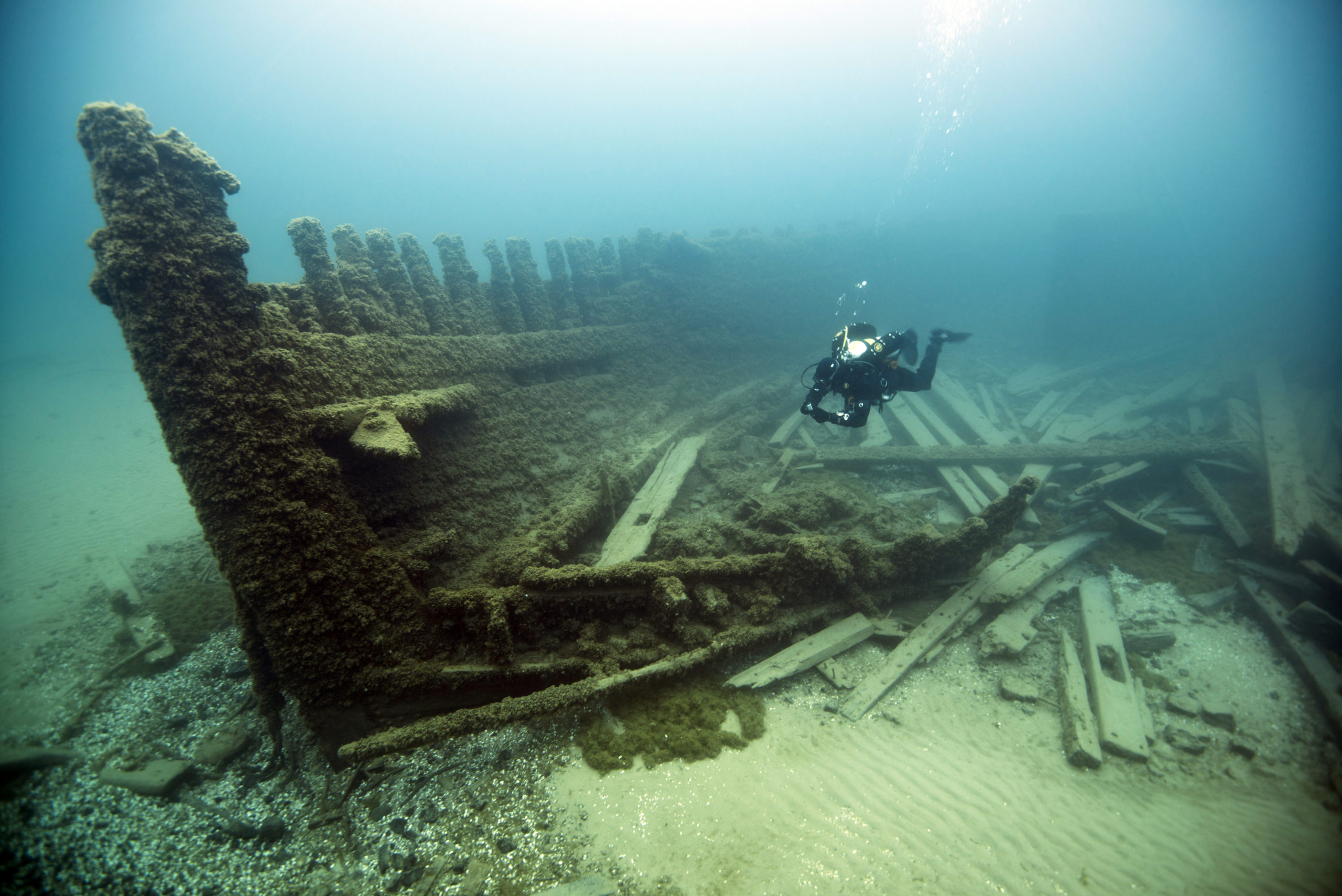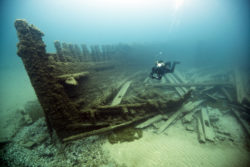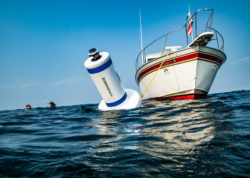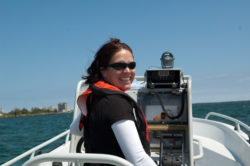
Diving to Protect the Rich Maritime History of the Great Lakes
By Stephanie Gandulla, Research & Media Coordinator for NOAA’s Thunder Bay National Marine Sanctuary

A scuba diver explores the site of the wooden schooner Lucinda Van Valkenburg, sunk in a collision in 1887. NOAA, Thunder Bay National Marine Sanctuary/Tane Casserley
“Dive! Dive! Dive!” Captain Travis Smith shouted as our 26-foot boat approached the coordinates to the sunken schooner Lucinda Van Valkenburg. Resting upright in 65-feet of water, the wooden vessel is just one of dozens of historic shipwreck sites where NOAA’s Thunder Bay National Marine Sanctuary maintains mooring buoys. Located in northwestern Lake Huron, the 4,300 square miles of sanctuary waters hold nearly 100 known shipwrecks, with an estimated 100 more yet to be discovered.
As research coordinator for the sanctuary, it is my fortunate duty to work with a team of fellow maritime archaeologists to search for, document, and protect some of the best shipwreck diving sites in the world. The collection, well-preserved by Lake Huron’s cold, freshwater, represents over a century of commerce in the heart of the continent. It includes 150-year-old wooden schooners and modern, massive steel freighters; together, they tell a story of a time when schooners and steamers ruled the lakes, linking America’s heartland to the Atlantic coast and the world. Individually, they tell a story of thousands of sailors who made their living taking risks in some of the world’s most treacherous waters.
As my dive buddy and I splash and quickly descend to the Lucinda Van Valkenburg, we note the crystal-clear visibility and see the sandy lake bottom almost immediately. Outfitted in dry suits, the 38-degree water doesn’t shock us immediately, but it won’t take long to feel the bitter cold of Lake Huron. Using a lift bag, we bring the end of the mooring chain from the subsurface float to the surface and Captain Travis and his deckhand secure it to the 100-pound, U.S. Coast Guard-approved buoy. With just one short dive, another sanctuary mooring buoy is set and ready for dive season. The sanctuary mooring buoy program is our principal outreach effort and visitors are encouraged to connect with these historical resources firsthand. Seasonal buoys allow paddlers, snorkelers, divers, and even glass bottom boat tours direct and easy access to more than 40 sanctuary shipwreck sites.

A dive boat is secured to a sanctuary mooring buoy, marking the site of the shipwreck Monohansett, sunk in a fire in 1907. NOAA, Thunder Bay National Marine Sanctuary/Nick Zachar
Diving to install and remove buoys is not the only task on the dive calendar. Our team engages in regular dive operations to document and monitor these historically significant sites. Archaeological documentation methods underwater range from traditional measuring tapes and dive slates to multi-diver photogrammetry to 3D imaging. The mission is to create a baseline characterization of each wreck site to better determine and understand physical changes.
When the lake freezes over and our dive gear is put away for the winter, our mission continues as we develop shipwreck site documentation into compelling outreach products and programs to share with the public. Although I love being on the water (and under!), sharing the rich maritime history of the Great Lakes is truly the highlight of my job. The sanctuary’s diverse outreach programs reach thousands of people every year, whether it’s in person at our interactive visitor center or online with a suite of virtual programs. One day I might be helping fifth graders learn how to build and operate underwater robots, and the next delivering a lecture about wooden schooner ship construction. Each day brings something different!
At the end of the day, whether we’re diving into Lake Huron or diving into advocacy, I know that the work my colleagues and I do in northeast Michigan creates a deeper connection for all of us to our country’s special places underwater.

Stephanie Gandulla is the Research & Media Coordinator for NOAA’s Thunder Bay National Marine Sanctuary, based in Alpena, Michigan, in the heart of the Great Lakes. Learn more about Thunder Bay National Marine Sanctuary, here.
